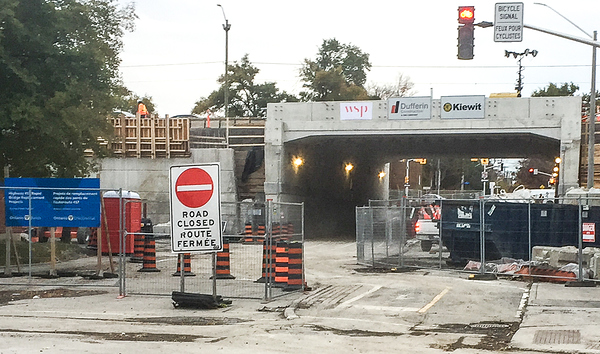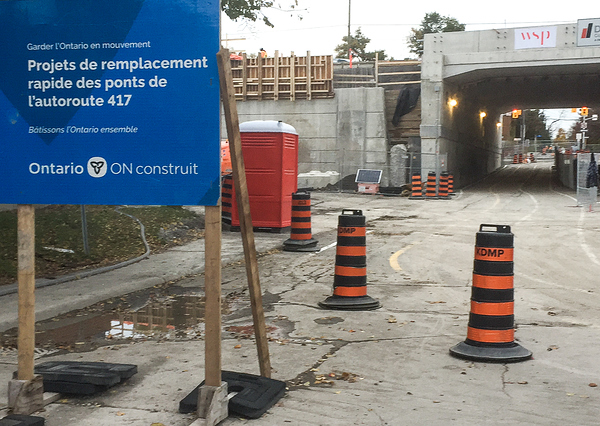
Alayne McGregor
Percy Street has reopened under the Queensway after its bridge replacement, but so far only to cyclists and pedestrians. And one nearby resident would prefer it stay that way.
Jamie (who requested his last name not be used) has written an opinion piece for local advocacy group Bike Ottawa, arguing that the connection is needed more for active transportation. It’s the only 30km/h local street crossing the Queensway in that area; others like Bronson or Bank are much less friendly to pedestrians and cyclists.
The Percy underpass has been closed to motorists for more than a year as part of preparations for the bridge replacement. Jamie, who lives on Percy near Catherine Street, said that he has observed a large reduction in the amount of through car traffic on Percy, as well as up to four times as many people biking and walking.

He said he counted traffic in the morning and evening peak hours a number of times before the underpass closed to everyone this summer for the bridge replacement. “What I observed was consistently double the number of cyclists using the street now vs. motor-vehicles. If you make a street safer to bike on, more people will bike on it.”
When the Percy underpass was open to cars, Jamie said that drivers looking for a short-cut to the freeway would use Percy to get to Chamberlain Avenue and Isabella Street, and then on to the Queensway. “For anyone who needs to go to Orleans, they would all take Percy. It’s like a magnet for that traffic. This is at odds with Percy Street being a local, residential street.”
Closing the underpass to cars would make all of Percy a “safer, quieter, and a more desirable bike route,” he said – which has already happened in the Glebe because motorists are not allowed to continue south on Percy past Chamberlain Avenue.
“Closing access to this underpass adds a mere minute or two for drivers trying to reach Chamberlain from Percy, as they simply detour a few hundred metres over to Bronson. But that small detour is enough to make Percy Street unattractive as a short-cut, and thus a much safer cycling street.”
He also noted that a 1981 traffic calming plan for Centretown called for motor vehicle traffic on Percy to be forced to turn right on Catherine, rather than being allowed to go through the underpass to Chamberlain. That plan also called for closing Percy at Gloucester, and disallowing left turns from Somerset onto Percy.
Jamie said he had talked to Somerset Ward Councillor Ariel Troster about the closure.

Percy has been a designated Ottawa bicycle route in Centretown for at least 40 years, one-way southbound from Laurier Avenue (twinned with Bay Street northbound). For the three blocks from Flora Street to under the Queensway, the street has a bidirectional cycle track allowing two-way traffic. The cycle track has been in poor condition for many years.
The Percy bridge on Highway 417 was replaced uneventfully on the weekend of October 19-24, after being delayed earlier this summer. Percy was scheduled to be fully reopened by November 6, with the road, sidewalk, and cycle track fully restored.
However, as of last week, a two-way bike/ped path snaked through the construction, and signs said that the underpass was not open to motorists. Jamie said progress seemed to be slow.

The BUZZ asked the Ministry of Transportation last week what the timeline was for opening the road under the bridge to motorists, removing all construction debris, and restoring the sidewalk and cycle track. We also asked if there were any factors delaying the reopening. As of press time, we had not heard back from MTO.
Bike Ottawa Secretary Florence Lehmann said the organization supports reserving the Percy underpass permanently for active transportation.
“Percy is already well used by people biking, walking or rolling. This would make it a safe, pleasant route for them. Which is not to say emergency vehicles couldn’t use it, an argument that is often thrown against active transportation projects.”
